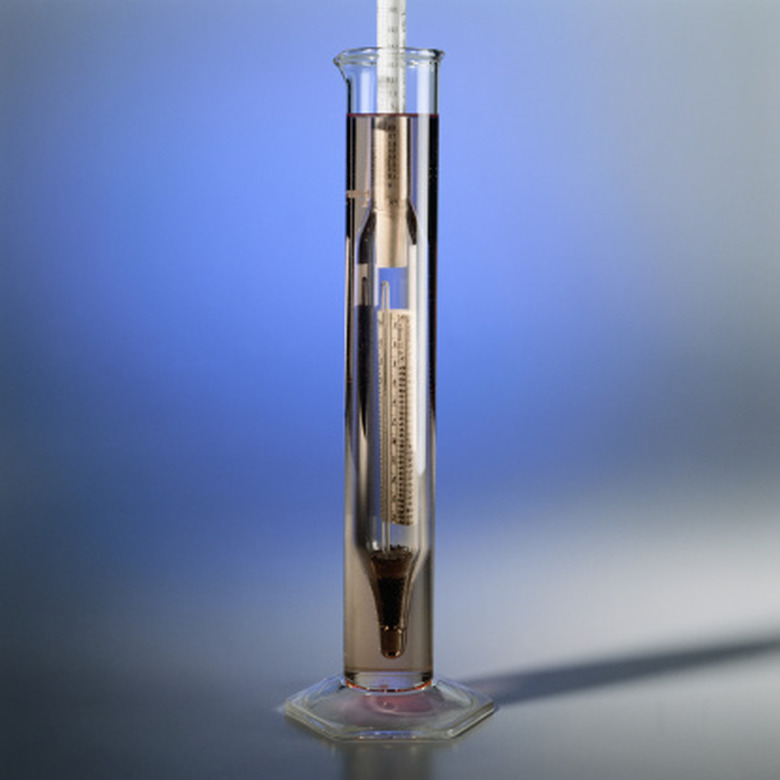How To Calculate Degrees In The Baume Scale
The Baumé scale measures the density of a liquid. First developed by French chemist Antoine Baumé in the late 1700s for use in making hydrometers, the Baumé scale is still used today in many industries including pharmacology, brewing, wine-making and the manufacturing of common household products.
How Do You Use a Baumé Hydrometer?
How Do You Use a
Baumé Hydrometer?
A Baumé hydrometer is a tool used to find a solution's specific gravity, as well as to estimate its concentration. It looks like a thermometer with a bulb on one end and degrees marked along its length. After placing the hydrometer in the liquid, the degrees' reading corresponds to one of two different scales for liquids with higher densities than water or with lower densities than water.
For water and liquids denser than water, zero degrees Baumé corresponds to a specific density of 1.000 (the density of water at 4 degrees Celsius). For liquids less dense than water, zero degrees Baumé corresponds to the density of a 10 percent sodium chloride solution.
Baumé Temperature Correction
Baumé Temperature Correction
Most modern Baumé hydrometers are calibrated to provide accurate readings at either 60 or 68 degrees Fahrenheit. The best practice for using the hydrometer and preserving its integrity is to heat or cool your liquid to the correct temperature before measuring it. If that's not possible, however, you can read a chart or use an online calculator to find the Baumé temperature correction according to the conditions when you took your data.
How to Convert Baumé to Twaddle
How to Convert Baumé
to Twaddle
A Twaddle is a simplified hydrometer scale used only for liquids with higher densities than water. To convert from Baumé to Twaddle, first find the liquid's specific gravity by multiplying the degrees Twaddle by 0.005 and adding 1. Then use either a chart to read the corresponding degrees Baumé for that specific gravity, or convert from that specific gravity to Baumé as explained in the next section.
Calculating Baumé Degrees from Specific Gravity
Calculating Baumé Degrees from Specific Gravity
- **If the liquid is less dense than water:** Divide 140 by the specific gravity, then subtract 130. For example, for ethanol, with a specific gravity of 0.78:
\(\dfrac {140}{0.78} – 130 = 49.5\)
The ethanol is 49.5 degrees Baumé.
- **If the liquid is more dense than water:** Divide 145 by the specific gravity, then subtract the result from 145. For example, for propane gasoline, with a specific gravity of 1.55:
\(145 – \dfrac {145}{1.55} = 51.45\)
The propane gasoline is 51.45 degrees Baumé.
Uses of the Baumé Scale in the Real World
Uses of the Baumé Scale in the Real World
Although most chemists today use more simplified scales and hydrometers to refer to the properties of a liquid, many trades still use the Baumé scale as a quick way to approximate the concentration of a solution.
For example, wine makers can read the Baumé degrees of a wine in production to estimate its final alcohol content by checking for the sugar density at a particular stage in the fermentation process. Producers of honey, syrups and juices find the scale similarly useful.
Additionally, as defined by the scale, Baumé caustic solutions can be found in stores for various cleaning and manufacturing needs, such as hydrochloric acid to clean a swimming pool (20 degrees Baumé).
Sodium hydroxide, which is also called lye and is used in the manufacturing of paper, aluminum, soap, detergents and other household products, can be much higher on the scale (50 degrees Baumé).
Cite This Article
MLA
Dusto, Amy. "How To Calculate Degrees In The Baume Scale" sciencing.com, https://www.sciencing.com/calculate-degrees-baume-scale-7405649/. 30 March 2020.
APA
Dusto, Amy. (2020, March 30). How To Calculate Degrees In The Baume Scale. sciencing.com. Retrieved from https://www.sciencing.com/calculate-degrees-baume-scale-7405649/
Chicago
Dusto, Amy. How To Calculate Degrees In The Baume Scale last modified March 24, 2022. https://www.sciencing.com/calculate-degrees-baume-scale-7405649/
